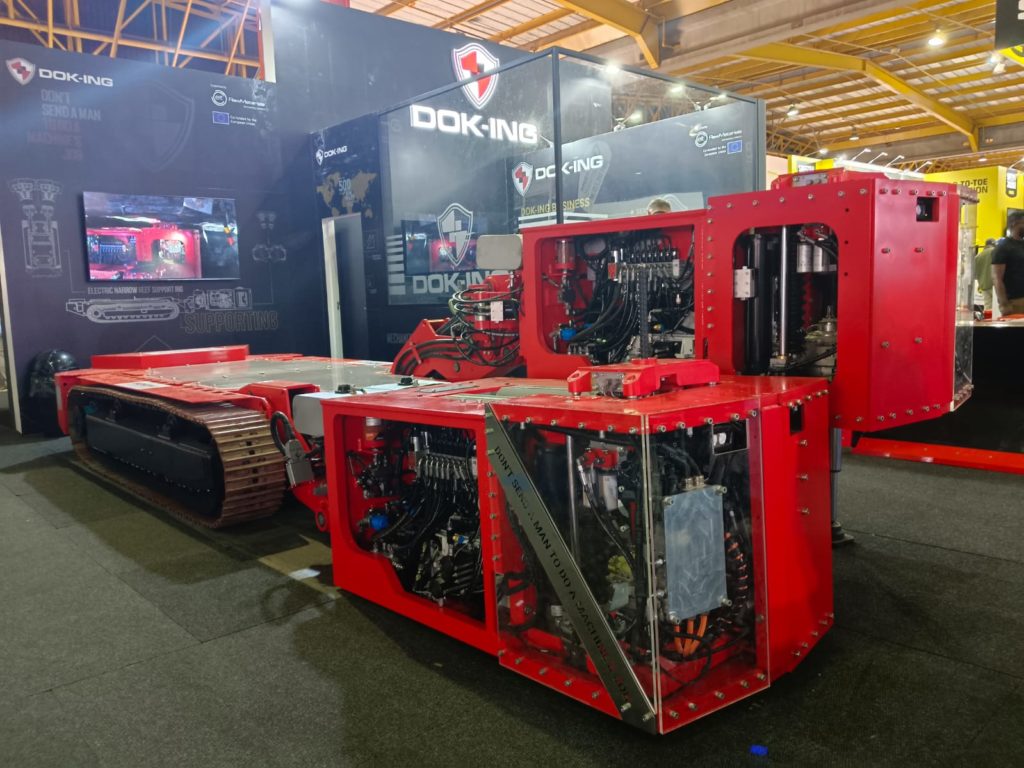DOK-ING showcased its innovative electric robotic NRE fleet and its latest product, a VR training simulator, at Electra Mining Africa, held from 2-6 September at the Expo Centre, Johannesburg. It says this largest mining fair in Africa served as the ideal stage for DOK-ING’s 100 m² stand with a team of 12 experts attending, including members of the Management Board, Sales and Program Managers and Engineers.
Visitors were able to see live all three NRE fleet groundbreaking robotic systems. The NRE Dozer, NRE Support Rig, and NRE Drill Rig cutting-edge systems were specially designed for platinum, chrome and gold extraction. Visitors at the booth also had the chance to try out a VR simulator.
The NRE fleet consists of three robotic systems: NRE dozer, NRE Support Rig and NRE Drill Rig which seamlessly complete the drilling, cleaning, and anchoring processes. The NRE technology enables mechanised exploitation in ultra-low profiles (0.9 m to 1.7 m), increasing safety, productivity, and more ore concentration leading to less waste and more selective extraction while reducing capital investment, less rock is excavated, which can reduce costs as in high profiles more rock is removed, increasing costs. With the development and production of NRE, DOK-ING “is expanding its product range and bringing innovation to the mining industry and pushing the boundaries of the efficiency of mining methods.”
The NRE fleet is remotely controlled, eliminating the need for personnel in unsecured areas. The fully automated roof drilling and supporting operations further enhance operator safety, ensuring a safer and more efficient mining process.
DOK-ING’s unique innovative NRE, measuring just 65 cm tall, are designed to navigate the world’s most challenging mines. The electric drive eliminates noise and impact of exhaust gases in confined spaces and reduces the carbon footprint of the overall exploitation process. Mechanisation of the production process increases production efficiency improves occupational conditions and drastically reduces risks for workers.
DOK-ING’s NRE fleet can handle slopes of up to 22°, surpassing the 10° limit of wheeled machines, and providing the underground mining industry with new opportunities. Luka Petro, Mining Program Manager at DOK-ING, noted: “The ability to operate on higher slopes opens up access to deposits that conventional machines can’t reach or would make unprofitable. This flexibility not only enhances mine design but also leads to significant cost savings.”
Utilisation of VR technology is revolutionising underground mining by enhancing safety, and operational efficiency while reducing training cost. Machine operators can practise on the NRE Dozer Robotic System in a controlled virtual environment, refining their skills and reducing errors before handling real equipment.
Scenario-based training improves proficiency and minimises risks. DOK-ING’s VR training module allows exploration of virtual mining sites, aiding in better-informed decisions and machine utilisation. They also simulate hazardous situations, helping miners learn to respond without exposure to danger. VR also facilitates remote collaboration and offers cost-effective training by reducing the need for physical facilities.
Guardiaris, a Slovenian company specialising in advanced training simulators for military, police, and civil sectors, has partnered with DOK-ING to develop a cutting-edge VR training simulator. Their innovative technology leverages virtual reality and digital tools to create highly realistic and secure training environments, allowing users to practice in immersive, life-like scenarios while ensuring maximum safety.
Underground mining remains highly hazardous, with risks like cave-ins, toxic gases while the physical demands, long shifts, and dust exposure contribute to musculoskeletal injuries and respiratory diseases. Despite advances in safety, these risks persist. Petro noted: “However, DOK-ING’s underground mining robotic systems enhance safety and efficiency, while VR technology trains operators to remotely control these systems effectively before entering the mines.”











